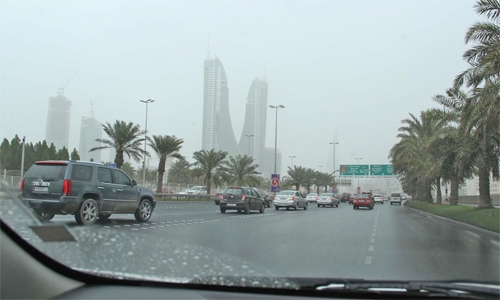Change in weather might cost you more for insurance
Manama : The unusual pattern of weather, with heavy rain and wind, in the GCC should force insurance companies in the region to reassess their risk exposures, according to the rating agency A.M. Best.
The GCC is often referred to as a region with very low chance of having an extreme natural disaster. The World Risk Index calculated by the United Nations University for Environment and Human Security lists 171 countries in the order of their exposure to natural disaster risk, and the countries in the region are among the least risk prone ones.
Bahrain has a rank of 164, with a risk per cent of 1.76. Qatar is counted as the country with least risk of only 0.08 pc.
This picture might be slowly changing, the rating agency warns, taking into account the recent flood and weather conditions in the region.
“While the Gulf has thus far experienced very little damage from wind and earthquake events, floods are a regular occurrence. These have been the result of storm surges, cyclones and flash flooding due to heavy rain.
In addition to the floods experienced in February 2016, recent years have seen heavy downpours in the UAE, Qatar, Kuwait, Saudi Arabia and Bahrain, and cyclonic activity in Oman in June 2015, November 2011 and June 2010. Jeddah, in western Saudi Arabia, also experienced significant floods in 2009, 2011, 2013 and 2015” the rating firm noted.
The rating agency stated insurers’ exposure to flood events, at least on their property books, is limited by the low level of insurance penetration for personal property, and home contents insurance in particular.
“As a result, total insured losses resulting from these events have been low so far and headline figures for economic damage have largely not been passed onto insurers. As insurance awareness and penetration increases across the GCC, exposures are likely to increase, making this a greater risk for insurance companies,” it added. A.M Best pointed out that most of the GCC is a desert environment, characterised by hard and dry soils, which do not absorb excess water quickly.
“This existing problem has arguably been exacerbated by patterns of economic and social urban development; as areas are increasingly tarmacked, water is less able to disperse without sufficient channels or sewerage. Also, urban areas across the Gulf have a heightened exposure to extreme rainfall due to a lack of adequate drainage infrastructure,” it stated.
A.M. Best added it believes that insurers will need to monitor their exposures and adjust their underwriting and reinsurance strategies to accommodate the risk.
If insurance companies take heed of the rating agency warnings, they might increase the insurance premiums along with other measures to prepare for the potential increase in claims in coming years.
Related Posts

